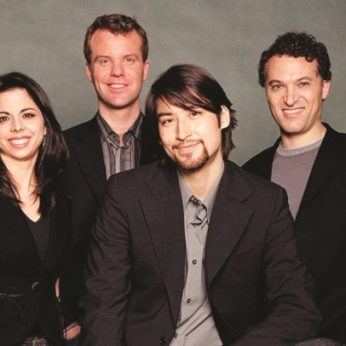Dvorák actually wrote two piano quintets though the first one is hardly ever performed. He wrote it in the summer of 1872, but seems to have forgotten about it until fifteen years later when his publisher was pressing him for new works. At this stage he unearthed a copy of the score the original quintet and tried to revise it. Clearly he felt this early work even with extensive revisions did not come up to standard and he immediately set about writing a second quintet in A major, which is the one we all know so well.
There are few works in the entire chamber music repertoire that have such an exquisitely beautiful opening, over a rippling piano accompaniment the cello breathes a gentle and wistful theme. This is rudely interrupted – in Dvorák’s customary way – by a lively version of a fragment of the theme. This eventually gives way to a luminous vision of the theme in its original form culminating with the solo violin singing out the theme before another rude and boisterous interruption – piano triplets, viola staccato quavers over an ostinato rhythm. Then another sudden change to the second subject, in the composer’s own instrument, the viola. The same abrupt alterations of moods are found here, initially quiet and melancholic, then loud and forceful, followed by a slow winding-down to the repeat of the exposition. The next time around it leads directly into the development with the same dynamic contrasts between yearning melancholy and wild gaiety, culminating with a dramatic statement of the main theme that moves immediately into the recapitulation extended by a spirited coda.
The dream-like opening of the Dumka mirrors the opening of the first movement, but without the same rude interruptions. This quietly sad theme recurs throughout the movement, most distinctively in the viola’s unmistakable voice. The second theme breaks in joyfully as a smiling duet between the violins. There is a brief central vivace section clearly related to the opening material, which soon returns, led by the viola. The same themes are then worked through again culminating in a long reconsideration of the increasingly hypnotic opening theme. The coda is an exquisitely quiet close.
The scherzo is dominated by the infectious gaiety and skipping rhythm of the main theme. There are subsidiary dances in different tempi but the main one keeps returning. The amorous trio is enlivened with the rhythm of the opening. The quintet ends with a stirring finale, the energy levels stoked by a riotous scatter of invigorating themes, returning inevitably to the opening Rondo theme. There’s an amusing mock fugue in the middle as if to say that even such an academic device can be made to dance. The end is jubilantly affirmative.
